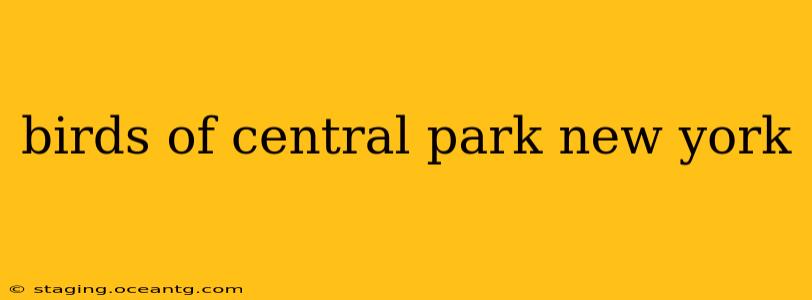Central Park, a vibrant green oasis in the heart of bustling New York City, is surprisingly rich in avian biodiversity. More than 200 species of birds have been documented within its boundaries, making it a fantastic destination for birdwatching enthusiasts of all levels. From the ubiquitous American Robin to the more elusive peregrine falcon, the park offers a captivating glimpse into the diverse world of urban birds. This guide explores the avian inhabitants of Central Park, offering insights into their habits, habitats, and the best times to spot them.
What birds can I see in Central Park?
This is a question frequently asked by visitors. Central Park's birdlife varies by season, but you can consistently spot a variety of common species. These include the ubiquitous American Robin, the ever-present House Sparrow, and the cheerful Northern Cardinal. During migration periods, the park becomes a vital stopover point, attracting a wider array of species, including warblers, flycatchers, and even occasional rarities. The specific species you see will depend greatly on the time of year and the location within the park. For example, the Ramble, with its dense vegetation, attracts different birds than the more open areas near the reservoir.
What are the best times to birdwatch in Central Park?
The best time to birdwatch in Central Park is during the dawn and dusk hours. This is when many birds are most active, singing, and foraging. Spring and fall migration seasons (April-May and September-October) offer the greatest diversity of species. Winter months, while less diverse, still offer opportunities to spot resident species like the Northern Cardinal, Downy Woodpecker, and various species of owl.
Where are the best places to birdwatch in Central Park?
Central Park offers several prime birdwatching locations. The Ramble, a wooded area with varied terrain, is a hotspot for woodland birds. The North Woods, another wooded area, provides similar opportunities. The reservoir attracts waterfowl like ducks and geese, while the Great Lawn offers views of birds soaring overhead. Each area provides unique habitats and attracts different bird species. Exploring different sections of the park increases your chances of observing a wider variety of birds.
What kind of birds are common in Central Park in the winter?
Winter in Central Park still offers exciting birdwatching opportunities, although the diversity is reduced compared to the migratory seasons. Common winter residents include the Northern Cardinal, easily identifiable by its bright red plumage; the Downy Woodpecker, a small woodpecker often seen searching for insects on trees; and various species of ducks and geese on the reservoir. Owls, such as the Great Horned Owl, can also be spotted, though they are more elusive.
Are there any rare birds that can be seen in Central Park?
While Central Park is known for its common urban birds, rare sightings do occur, especially during migration. The park's location along major migratory flyways occasionally attracts unexpected visitors. These rarities are often reported on birding websites and social media groups, so keeping an eye on these resources can help you plan your visits accordingly. Remember to respect the birds and their habitats while searching for these rare sightings.
What equipment do I need for birdwatching in Central Park?
While you can certainly enjoy birdwatching in Central Park without any special equipment, binoculars will significantly enhance your experience. A good field guide to North American birds will aid in identification. Comfortable walking shoes are essential, as you’ll be doing a fair amount of walking. Finally, consider bringing along a camera with a telephoto lens if you’re interested in capturing images of the birds you spot.
Conclusion:
Central Park's avian population offers a rewarding experience for any bird enthusiast. By understanding the best times and places to visit, and armed with the right equipment, you can enjoy countless hours observing the fascinating variety of birds that call this urban oasis home. So, grab your binoculars, and embark on a feathered adventure in the heart of New York City!
